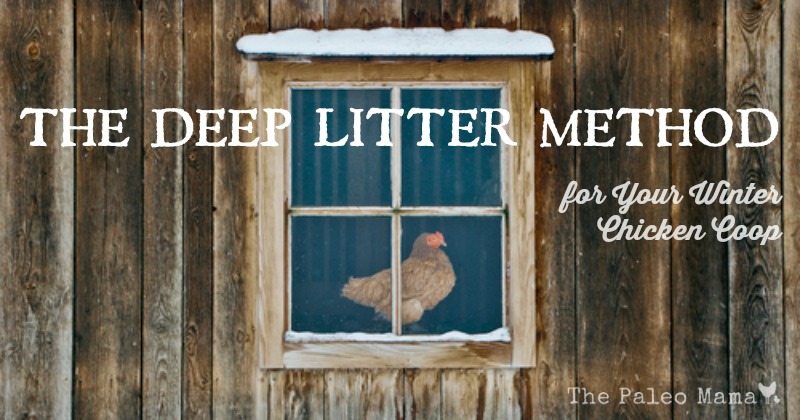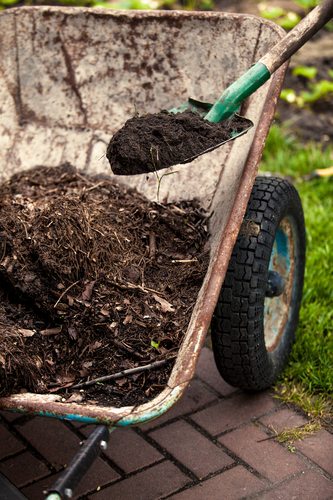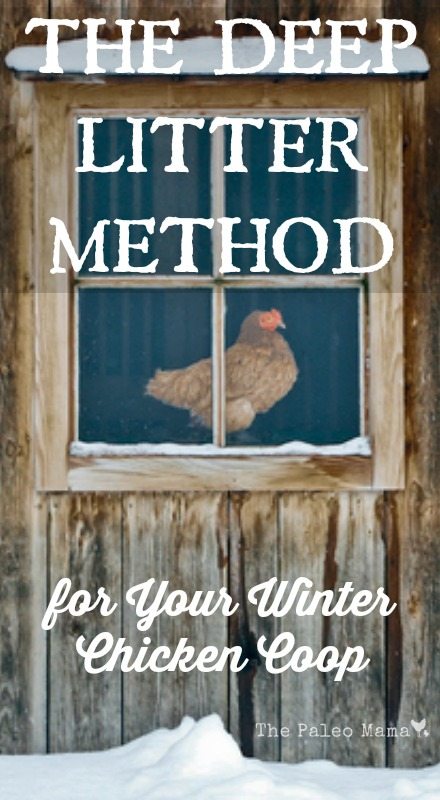
If you’ve been following me online, you already know that during the last six months or so I’ve been decluttering our home and farm using the KonMari Method (HERE) for simplifying, organizing, and storing only those things that “spark joy” for us. It’s been a real eye-opening time, and we’ve gotten rid of tons of stuff! SO…this post on The Deep Litter Method for your winter chicken coop may at first sound like an oxymoron! But I assure you it isn’t—what it is is one of the easiest and healthiest ways to prepare your chicken coop for the cold winter months.
You see, my chickens are a real source of joy for us and make the perfect pet. We are raising heritage breeds, and thoroughly enjoying the ability to help protect these endangered breeds, as well as being thrilled with the dozens and dozens of eggs they give us, and the tasty chicken meals we are able to have from their gift of life to us when needed. Taking the best care of them at all times is our prime goal—especially during the cold months of our North Carolina winters.
The deep litter method allows your coop litter to build up over a period of time. As the chicken manure and bedding litter compost, it helps to heat the coop, keeping your chickens warmer. This is also called “The Old-Timers Method,” because it’s been used successfully by many chicken farmers for decades. And an added benefit (“joy” for us KonMari followers) is lots of beautiful compost for our spring gardens.
Let’s take a look at these things:
- Preparing Your Coop for the winterizing Deep Litter Method
- Managing the Deep Litter method in your coop through the winter months
- Doing spring cleaning of your coop when winter ends
- The Benefits of the Deep Litter Method
1. Preparing Your Coop for the Winterizing Deep Litter Method
You prepare your coop for the winter months by beginning with a deep cleaning. Pick a nice, sunny day and shovel out all the soiled straw and litter in the coop. This is also a great time to check the exterior of the coop for loose screws, hinges, shingles and to make any repairs necessary before winter.
Once your coop is cleaned thoroughly, put a fresh 6-inch layer of pine shavings down on the bare floor. This is the best bottom layer for the Deep Layer Method because they are small and will compost fairly quickly. Put a thin layer of straw over the shavings. Note: Do not use Diatomaceous Earth (DE) for this method. It will kill the good microbes and just is not beneficial to have in your composted soil.
Now you begin deep littering. Each morning turn over the pine shaving and straw, adding more straw as needed until you have a 12-inch layer. You are not removing anything, simply turning it over to expose new straw. You can also add leaves, grass clippings, and weeds during this initial preparation period. You may need to add a 12-inch board at the door of your coop to keep the litter inside for the winter.
Chicken manure is very high in nitrogen. Mixing it with a source of carbon (either straw, shavings or dry leaves) will balance the mixture and hasten the rate of decomposition. It is important that your composting material contain oxygen, so turning is crucial. Fortunately the hens will help you with that part, especially if you get in the habit of tossing some scratch or sunflower seeds into the coop for them before bedtime. They will learn to scratch through the litter to find the scratch when they wake up in the morning. You can also turn the material with a rake. The turning and introduction of oxygen will reduce the chance of ammonia buildup.
After just a few weeks, the droppings, shavings and straw will start to decompose and you will end up with a fine dirt on the bottom. As anyone who composts for their garden knows, when properly done, composting does NOT smell and does generate quite a bit of natural heat. This is the same idea as you would do in a compost pile or bin, you’re just doing it inside your coop!
2. Managing the Deep Litter method in your coop through the winter months
Once you have your healthy 12-inch layer of litter on your coop floor, you are set for the winter months. You will need to follow some simple steps to keep your chicken coop in good health throughout the winter:
- Stir up the bedding to break up any clumps every few days.
- Keep layering clean bedding on top of the old bedding or any moist spots.
- To keep your girls happily scratching, toss in a bit of chicken feed when you layer in the fresh straw.
- If the floor becomes frozen (only in very cold climates), break it up with a pitchfork so your girls can begin scratching again.
- You should be able to kneel down on the floor and your knees should remain dry.
3. Doing spring cleaning of your coop when winter ends

Your perfect opportunity for decluttering your chicken coop will come with the entrance of spring. Now you get to do your thorough spring cleaning in the chicken coop. Clean out most—not all—of the litter. Leave a base layer (1-2 inches) to inoculate new material with the established beneficial microbes.
As with any decluttering of junk (in this case poop) it’s not fast, easy or fun. It’ll take quite a while to shovel out 1-2 feet of poop encrusted litter. So, with each scoop of poop, just remind yourself that these few hours of pain make the long winter months so much more tolerable for you.
If the litter you remove is thoroughly decomposed and odorless, you can work it directly into your garden beds. If some of the fresher manure hasn’t thoroughly decomposed, simply add it to your other compost pile. If you want to speed up the composting process by helping to keep the compost pile hot, try some Chicken Poop Tea! To make the tea, just fill a couple of buckets half full of water, and then add in the poop until the buckets are full. Stir frequently—holding your nose–and keep the buckets covered. Your chicken poop tea is extremely strong, and should not be applied directly to your garden plants. Use it to keep your compost pile doing its thing—composting.
4. The Benefits of the Deep Litter Method
By now you understand the reasons why using the Deep Litter Method during the winter months is a win-win solution for your chicken’s health and happiness. So let me just finish by listing the main benefits for using this method.
- It is the most natural and most rational method for manure management.
- It brings winter happiness to the chicken owner because it lessens the need to do cold weather cleaning of coop.
- It relieves winter boredom for the chickens who love having a place that is warm and safe, and which allows them to scratch around endlessly in the deep litter floor.
- The microbial action in the litter turns a potentially disease-causing problem into a substrate for health—studies have shown that this method has positive feeding benefits.
- The deep organic duff insulates the floor of the coop, while the warmth of its decomposition moderates the chill.
- Finally, this process captures the fertility in the manure for soil building in your spring garden—the key to food self-sufficiency.
Need I say more? I love the Deep Litter Method of sparking joy for both my chickens and for me. No oxymoron here!

Sources:
- https://www.backyardchickens.com/a/deep-litter-method-the-easiest-way-to-deal-with-chicken-litter-dlm
- https://www.fresheggsdaily.com/2012/02/deep-litter-methodcoop-cleaning.html
- https://www.grit.com/animals/chicken-health-deep-litter-zm0z13jazgou.aspx?PageId=6
- https://www.motherearthnews.com/homesteading-and-livestock/deep-litter-method-zb0z1208zmat.aspx
- https://chickenjunkie.com/chicken-coops/cleaning-the-coop/chicken-poop-control-the-deep-litter-method/
Excellent step by step. I have always used DE, though I do so in moderation, and have never felt it hurt my compost at all. It is good to know that it could be unhealthy for good compost so folks know not to use to much. I have been following the deep litter method for about 4 years now and love it. The biggest worry I had before I started using it was the lengthy clean up process in the spring and it was a silly thing to worry about, it does not take much time at all to clean it all up and start fresh come spring.
Thank you for sharing your method was an enjoyable read.
The Broke Dad
Have hopes to build a coop in the spring, most plans that I like have suggested a linoleum floor as a base. Can the deep litter method be used on top of a linoleum based floor?
Linoleum will probably not compost at all because it does not have moisture and microrganisms from the dirt, but some who have used it say it does stay dry and there is little smell.
Thanks for the info! I have a few questions though. Will this method work if the floor of the coop is raised and made of wooden boards? And what do you do on the floor of the coop during the rest of the year? Thanks.
Yes it would work for that kind of coop.
The rest of the year we cleaned out weekly.
Will wood pellets work in place of pine shavings?
You could use wood chips.